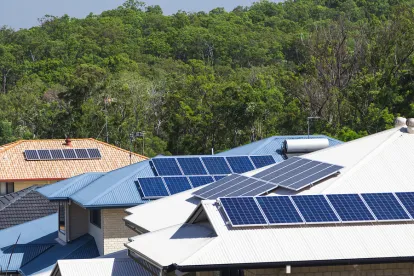The California Department of Toxic Substances Control (DTSC) has proposed regulations that would allow discarded photovoltaic (PV) modules (commonly referred to as solar panels) to be managed as universal waste. The proposal would put discarded solar panels in the same category as discarded electronic devices, batteries and light bulbs: ubiquitous, relatively low-risk hazardous wastes that are allowed to be managed under the more relaxed universal waste standards. DTSC states in the rulemaking proposal that regulating hazardous waste PV modules under the state’s universal waste standards will divert PV modules from the state’s municipal solid waste landfills and will encourage the proper end-of-life management of this emergent waste stream.
Background
California has been a leader in the installation of solar energy with nearly 40 percent of the country’s total solar capacity and 50 percent of the solar energy systems installed in the U.S. Solar energy demand in California is expected to remain high in the coming years, due in large part to the state’s ever-growing framework of laws and policies aimed at promoting the use of clean energy (including, notably, the adoption of new building standards that require solar-powered systems to be installed on nearly all new homes starting in 2020).
Most solar panels have an expected lifespan of approximately 30 years and, therefore, the inevitable end-of-life issues associated with these products have recently begun garnering the attention of regulators in several states, including California. Solar panels often contain heavy metals, such as cadmium, copper, lead, selenium, and silver. As such, when PV modules are discarded as waste, they may exhibit the hazardous waste characteristic of toxicity and, therefore, be classified as hazardous waste under the Resource Conservation and Recovery Act (RCRA) and/or California’s more stringent Hazardous Waste Control Law. According to DTSC, analytic testing data suggests that many PV modules would fail the federal and/or state hazardous waste criteria for toxicity. However, conducting the analytic testing required under federal and state law can be technically challenging and costly. Therefore, DTSC has proposed regulations that would allow people generating waste PV modules to avoid conducting hazardous waste testing protocols for toxicity and chose instead to handle waste PV modules in California as universal wastes, which impose lesser requirements than those imposed on hazardous wastes.
Proposed Regulations
DTSC’s proposed regulations would:
- Add PV modules to the list of hazardous wastes eligible to be managed as universal waste.
- Establish universal waste management standards applicable to accumulating, handling, treating and transporting PV modules.
The proposed regulation is written broadly such that it would purportedly apply to hazardous waste PV modules exhibiting the hazardous waste characteristic for toxicity under both federal and California criteria. However, as DTSC acknowledges in its Initial Statement of Reasons, DTSC does not currently have the authority to allow PV modules that are RCRA hazardous waste to be managed as universal waste because California’s Universal Waste Program has not been approved by the U.S. Environmental Protection Agency (EPA). Therefore, unless and until EPA approves California’s Universal Waste Program, the regulation, if adopted as proposed, will only be effective as applied to California-only hazardous waste PV modules that meet the state criteria for toxicity. The implications of this limitation, as well as others contained either explicitly or implicitly in the proposed regulation, are discussed more fully below.
Proposed Addition of PV Modules to California’s List of Universal Wastes
California’s existing universal waste regulations identify seven categories of hazardous waste that are exempt from regulation under California’s Hazardous Waste Control Law and implementing regulations, provided that they are managed under the alternative universal waste management standards contained in Title 22, California Code of Regulations (C.C.R.), Division 4.5, Chapter 23:
- Batteries.
- Electronic devices.
- Mercury-containing equipment.
- Lamps.
- Cathode ray tubes.
- Cathode ray tube glass.
- Aerosol cans.
DTSC’s proposed regulations would add PV modules as the eighth category of hazardous waste that may be managed as universal waste in the state.
DTSC’s proposal defines “photovoltaic cell” as “a specialized semiconductor diode designed to convert solar radiation into electrical energy,” and “photovoltaic module” as “a device consisting of one or more electrically connected photovoltaic cells that are protected, such as in glass, and designed to convert solar radiation into electrical energy” and includes “any ancillary components such as metal frames used to support the module, junction boxes, batteries, inverters, wires, and cables that are connected to and are part of the photovoltaic module.” The proposed definition specifies that “photovoltaic modules” include, but are not limited to, the following PV module types:
- Monocrystalline silicon.
- Polycrystalline silicon.
- Amorphous silicon.
- Cadmium telluride.
- Copper indium gallium selenide.
- Gallium indium phosphide/gallium arsenide/gallium.
The proposed regulations specify that the universal waste management standards in Chapter 23 would not apply to the following PV modules:
- PV modules that are not “waste” under California’s hazardous waste regulations.
- Discarded PV modules that were previously identified as “waste” but are no longer “waste” (e.g., due to refurbishment).
- PV modules that are not classified as hazardous waste under California’s hazardous waste regulations.
- PV modules that exhibit any characteristic of a hazardous waste other than toxicity.
- PV modules that are destined for recycling by being placed on the land (i.e., used in a manner constituting disposal).
- PV modules that are destined for disposal as hazardous waste at a permitted hazardous waste disposal facility.
- PV modules that are managed as hazardous waste.
- PV modules that are “integrated into the structure of electronic devices” (e.g., calculators).
The proposed applicability provision also clarifies that:
- A used PV module become “waste” on the date it is discarded.
- A party that is the subject of an enforcement action who claims that a PV module is not waste “bears the burden of demonstrating that there is a known market or disposition for its use as a PV module.”
Proposed PV Module Universal Waste Management Standards
The proposed regulations establish an alternative to full hazardous waste management standards that would apply to entities that generate, handle, transport, treat and recycle or dispose of PV modules as universal waste. If adopted as proposed, the alternative universal waste standards would include the following prohibitions and requirements on such entities:
- Universal waste PV modules may not be disposed of; however, handlers may send PV modules to an authorized universal waste destination facility for disposal.
- If PV modules are accepted and accumulated from an off-site source, written notification must be provided to DTSC no later than 30 days before accepting waste PV modules. Additionally, an EPA Identification Number must be obtained before waste is accumulated in quantities of 5,000 kilograms (approximately 11,000 pounds) or more.
- Annual reporting requirements are triggered if 5,000 kilograms (approximately 11,000 pounds) or more of waste PV modules are generated or more than 100 kilograms (approximately 220 pounds) of waste PV modules are accepted from off-site sources within a calendar year.
- PV modules must be managed in a way that prevents unauthorized releases of constituents into the environment. Specific management standards include handling and containing PV modules in a manner that prevents breakage and releases of constituents into the environment.
- PV modules, containers holding PV modules and/or areas designated for storing PV modules must be clearly labeled or marked with the phrase “Universal Waste – PV module(s)”.
- Waste PV modules cannot be accumulated for more than one year from the date the waste is generated, and accumulation times must be documented by including accumulation start dates on labels, maintaining an inventory system, etc.
- Handlers are prohibited from diluting or treating PV modules, except where responding to a release or where conducting “treatment” activities specifically authorized in Chapter 23. The following types of treatment activities are specifically authorized under the proposed regulations, provided that various enumerated requirements and limitations are satisfied:
- Removing “discrete assemblies” which are typically removed for replacement during the normal operation of a PV module (e.g., removing batteries or inverters), (provided that, among other things, the removal methods specified in the product’s operating manual are followed).
- Dismantling, removing or manually segregating components of a PV module (provided that, among other things, the activities are conducted without breaking the glass, all scrap metal components are recycled, and the notification, reporting and recordkeeping requirements applicable to treatment activities in Chapter 23, Article 7 are satisfied).
- Intentionally breaking the PV modules, conducting physical treatment methods that only change the physical properties of the PV modules and/or physically separate the modules into components (provided that, among other things, the methods do not apply or use chemicals, water or heat, and the notification, reporting, recordkeeping, processing standards, closure and financial assurance requirements applicable to treatment activities in Chapter 23, Article 7 are satisfied).
- Personnel who handle waste PV modules must be trained annually on proper universal waste management and emergency response procedures, and records must be kept documenting all personnel training for at least three years.
- Waste PV modules may only be transported to other universal waste handlers, an authorized universal waste destination facility or a foreign destination. If a handler self-transports waste PV modules off-site it must comply with the universal waste transporter requirements in Chapter 23, Article 5.
- Shipments records (e.g., bills of lading, invoices, logs, manifests, etc.) for waste PV modules sent off-site and waste PV modules accepted from other handlers must be prepared and maintained for at least three years
Next Steps, Key Takeaways, and Potential Impacts
DTSC is holding a public hearing on the proposed regulation on June 10, 2019, at its Sacramento Regional Office from 1:00 – 3:00 p.m. Written comments on the proposed regulations will be accepted through June 10, 2019. Additional information regarding the public hearing and comment period is available on DTSC’s PV module rulemaking webpage.
A major point of contention during the rulemaking process has been whether the regulations would unnecessarily and unduly restrict a handler’s ability to cut or break solar modules. Cutting and breaking of solar modules is a common activity that occurs during the disassembly process as it enables, among other things, efficient transport of the modules. DTSC’s proposed regulations appear to offer a compromise on this point, as DTSC’s proposal enumerates the intentional cutting and breaking of PV modules as a type of authorized treatment activity. Although this expands the scope of authorized treatment activities from what DTSC has previously proposed, the latest proposal still draws burdensome distinctions between “intact” and “broken” modules, as well as imposing requirements on intentional breakages, such that disassembly activities at the point of generation (e.g., on the roof of a building) could not include limited intentional cutting and breaking of the modules.
This rulemaking has been a long time in the making (DTSC originally proposed a similar rule in 2013 but hit a roadblock when the Office of Administrative Law determined that legislative authorization was required before the rule could proceed) and there is still at least one obstacle that needs to be overcome before the rule can have full effectiveness, as contemplated by DTSC. As previously mentioned, California’s Universal Waste Program has not been approved by EPA, as of today’s date. Therefore, unless and until EPA approves the state’s Universal Waste Program, discarded PV modules that are classified as RCRA hazardous wastes must continue to be managed as hazardous waste, even if the waste remains within California state boundaries. Although DTSC acknowledges that EPA approval has not yet been obtained and that the lack of approval impairs the effectiveness of the proposed rule, it does not provide any further insights on this issue, including whether it has an estimated timeline for when it will receive approval, if it will delay finalizing the rule if EPA approval is not obtained by the time it is ready to publish the final rule (presumably, in late 2019), or, if it plans to proceed with finalizing the rule without EPA approval, if guidance will be provided on how regulated entities can navigate through this issue without running afoul of applicable federal and state requirements. For instance, will DTSC advise the regulated community to continue making hazardous waste determinations on discarded PV modules in order to assess whether the modules are RCRA or non-RCRA hazardous wastes, even though one of the stated purposes of its proposed rule is to enable generators to avoid the obligation of conducting a hazardous waste determination on this waste stream?
Aside from the potential issue of partial inapplicability discussed above, it remains to be seen whether other states will follow California’s lead on this front, particularly in light of the fact that Washington has taken the alternate path of addressing the end-of-life issues associated with PV modules through the adoption of a mandatory, manufacturer-funded PV Module Stewardship and Takeback Program, and the discernable trend favoring extended producer responsibility schemes throughout the country. Indeed, there is a bill currently pending in the New York State Legislature that follows Washington’s template in establishing a mandatory solar panel takeback program.





 />i
/>i

